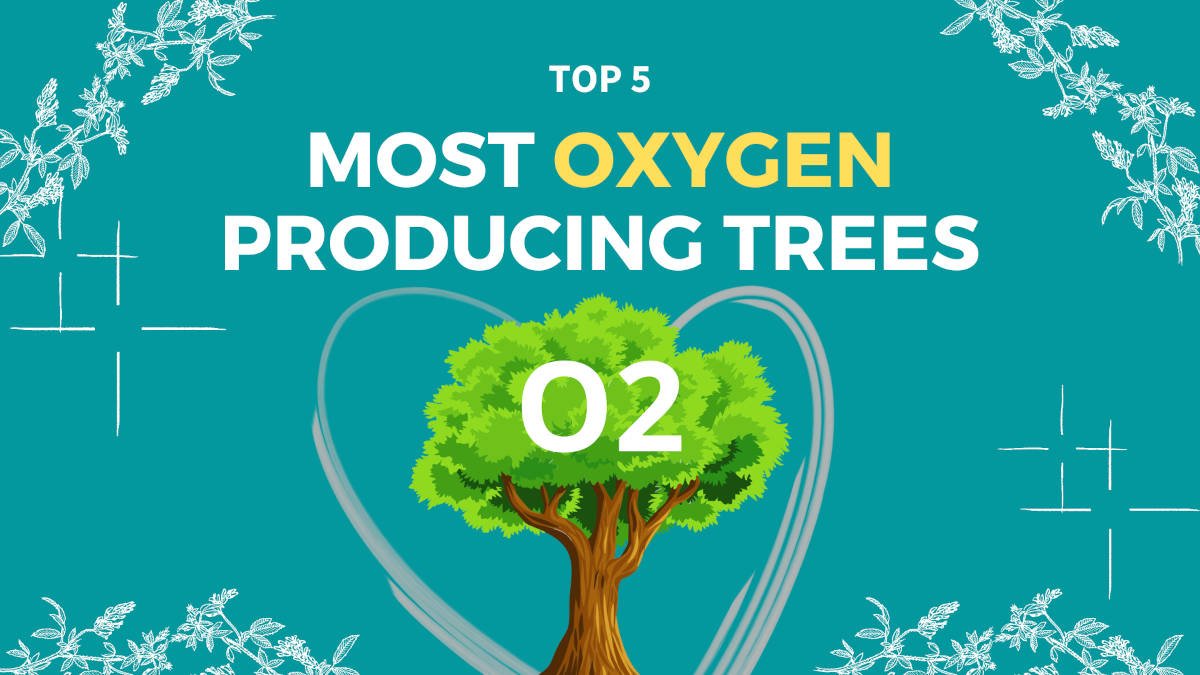Trees and grass give us oxygen and help improve the environment. With sustainability in our hearts, many of us may be wondering: which trees produce the most oxygen?
Key Takeaways
- Douglas-Fir, True Fir, Beech, Spruce and Maple are among the ones that produce the most oxygen.
- Aspen and Oak are halfway for oxygen production.
- Pine trees are generally releasing less oxygen because they have smaller leaves.
Now let’s look more in detail at the top 5 most oxygen producing trees, how they do it and some little known secrets about them.
For example, How much oxygen does a tree produce? Can trees produce oxygen without leaves? Do trees actually produce the most oxygen on our planet? Read on!
How to identify which trees produce the most oxygen?

Before going through our top 5 trees that produce the most oxygen, it is important to know what has the greatest impact on this activity for the trees. Let’s go through the main factors, so we can better understand why each specific tree made it to our list!
Tree growth rate: important factor influencing oxygen production
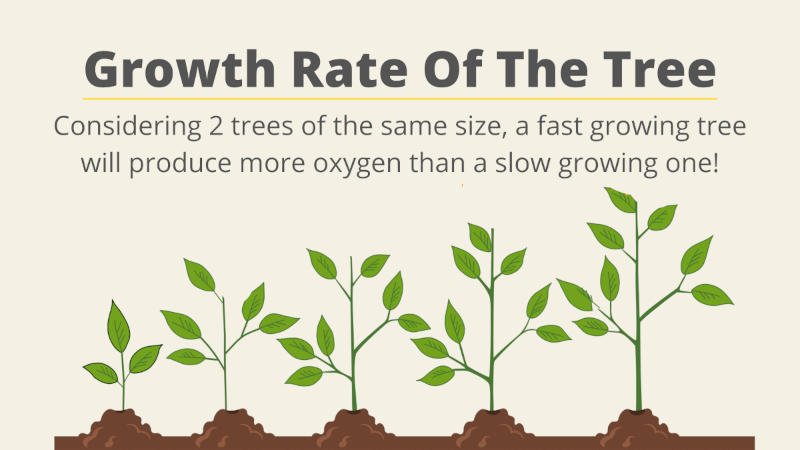
If you are looking at which trees produce the most oxygen as an aggregate, then you should first consider the law of conservation of mass, and apply it to the single tree as a physical system. According to this fundamental law of physics, “mass is neither created nor destroyed in chemical reactions” (Antoine Lavoisier 1789). As a consequence, the most important factors to consider when trying to identify the most oxygen producing trees are by far the following:
- How quickly is the tree growing? Considering two trees of the same size, a fast-growing tree will absorb a lot more water and carbon dioxide (producing also more oxygen) than a slow-growing one. In fact, the absorbed carbon is not disappearing but rather used together with water to create sugar. This, together with other nutrients absorbed from the ground, is finally used to grow the tree’s trunk, roots, stems and leaves. On the other hand, the excess oxygen not needed for cellular respiration (yes, also the cells of trees are breathing oxygen) is discarded and released into the atmosphere. In other words, we could consider a tree as a sort of carbon warehouse. That’s why the quicker a tree is growing its mass, the more CO2 and water it will have to absorb and the more oxygen it will release into the environment.
- How long does the tree live and what happens to it when it dies. Given what I explained in the previous point, the longer a tree is alive and growing, the longer it will be able to keep its stored carbon and continue to release oxygen. But what happens when the tree dies? It will of course decompose. During this process, the bacteria and fungi of the ground will release almost all of the carbon the tree stored during its entire life (always due to the principle of mass conservation). On the other hand, the decomposition process will also release important nutrients into the soil. If instead the old tree is cut and then used to build a house or for any other long term use, its trunk will not rot and it will continue to keep the stored carbon. This means that responsible management of forests applied in environmental sustainability is a good thing in terms of overall carbon balance by allowing the continuous renewal of trees while minimising the release of carbon into the atmosphere.
Leaf Area Index (LAI) and tree oxygen production

Another very important measure when looking for the most oxygen producing trees is their Leaf Area Index (LAI), which represents the total (one-sided) surface of the tree’s leaves per unit of the occupied ground surface. The Leaf Area Index of the canopy is a measurement related to the amount of light a tree can be exposed to.
Considering that the amount of oxygen produced by a tree is directly proportional to its capacity to capture light and photosynthesize, the higher the Leaf Area Index and the more oxygen will be produced per unit of occupied ground area.
In other words, the tree with high LAI will be more efficient, producing more oxygen while occupying the minimum ground surface.
Other factors influencing the oxygen released by a tree
Of course, there are many more factors to consider when identifying the most oxygen producing trees, for example:
- Where is the specific type of tree growing? Is it growing in a cold, or warm climate? Trees in a warm climate will benefit from more sunlight all year round, while trees in cold climates will not. However, in a cold climate, the tree will likely be an evergreen, producing less oxygen but releasing it more constantly during the entire year. Also, it was demonstrated that cold temperatures are slowing down photosynthesis as well, which will have a negative impact on the production of oxygen.
- Is the tree an evergreen or deciduous? In the summary of the most oxygen producing trees at the beginning of this article, you will find a mixture of evergreen, deciduous and coniferous trees. However, this factor will for sure impact the oxygen production patterns of the specific tree, because a tree without leaves will produce very little oxygen or nothing at all, while the decomposing leaves on the ground will actually release CO2.
- What’s the type of soil? Different trees need different types of soil, so even the best oxygen producing tree will have a poor performance if placed in the wrong place. I will assume that each tree is in its ideal environment.
Top 5 most oxygen producing trees
Knowing the most important factors needed to identify the most oxygen producing trees, we can populate our list with fast-growing and high Leaf Area Index (LAI) trees. So, what Trees Produce The Most Oxygen? Here are the top 5!
maple tree
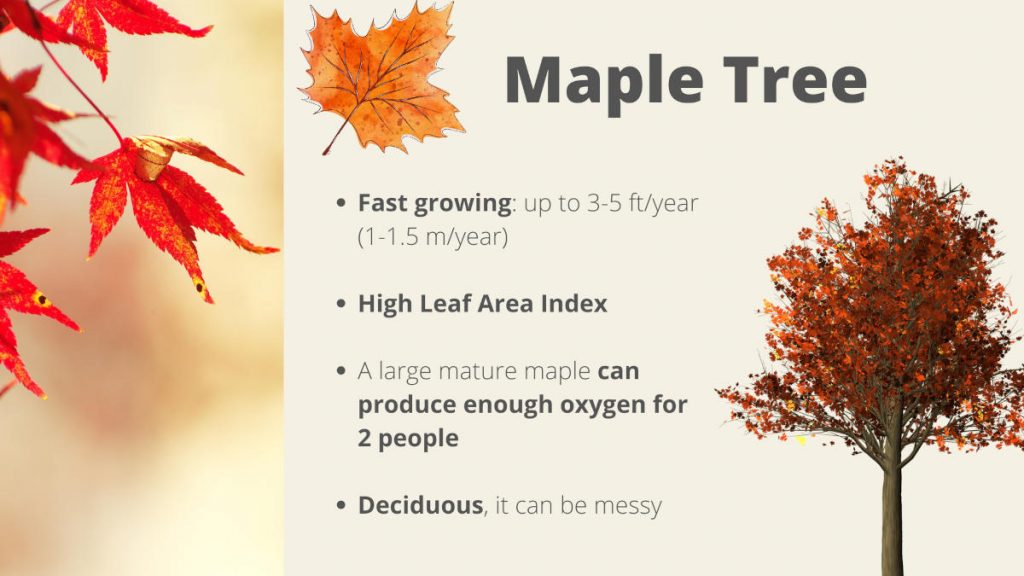
There are about 132 species of maple tree, mostly distributed in the northern hemisphere, especially in Asia. However, we can find several species of maple also in Europe, North America and North Africa. Only one species extends also to the southern hemisphere.
The most common maple tree species in North America are red maple, boxelder, sugar maple, bigleaf and silver maple.
Maples are beautiful and colourful trees of the genus Acer. They are easy to recognise thanks to their palmate leaves (similar to the fingers of a hand) with amazing colours during the different seasons and flying winged seeds.
Maple trees, depending on the species, can be quite messy, because they are deciduous and they also have helicopter winged seeds that will spread around with the wind.
The sap of some maple species is also used to make the delicious maple syrup.
Maple trees are typically between 30 and 80 ft (9-25 m) and they can grow up to 3-5 ft (1-1.5 m) per year. Red maples in particular are among the fastest growing trees and have a high leaf area index.
Maples, thanks to their fast growth and large leaf area are among the most oxygen producing trees.
For example, a mature maple can produce enough oxygen in one year for about 2 people and it will absorb about 48 pounds of CO2!
Spruce tree

The spruce tree belongs to the genus Picea. They are evergreen and comprise about 35 different species distributed in the temperate zones of both the northern and southern hemispheres.
You can recognise a Spruce by its needle leaves, which differ from other pines because they are four-sided and are connected to small joints named pulvini.
The needle leaves are shed only every 4-10 years, leaving a rough surface because of the remaining pulvini.
A Spruce tree can be as tall as 200 ft (60m) with a conical shape.
Norway Sources can have a very long life: scientists found a 9550 years old spruce tree in the western mountains of Sweden. This is believed to be the oldest living tree in the world and it has been named Old Tjikko.
The wood of Spruce trees, also known as Timber, it’s a very popular one used in construction.
Researchers discovered that despite the relatively low leaf area index of the Spruce tree when compared to a Beech tree (more down in our list), it can actually produce 58% more oxygen! This is achieved thanks to its ability to photosynthesize for about 260 days per year, against the 176 days a year of beech trees, making it one of the most oxygen producing trees. Quite incredible!
Douglas-fir tree

The Douglas-fir is an evergreen tree of the family of Pinaceae and native to North America.
Douglas firs are coniferous trees with linear needle-like leaves of about 0.75-1.5 in (2-4 cm) each. Each leaf is on its own and they are present all around the branches.
Those trees can be quite large and grow up to 330 ft (100 m) tall. Douglas-firs can generally live up to 500 years.
The seeds of those trees are an important source of food for wildlife, especially squirrels and other small mammals.
Also, those trees are used to produce timber for construction works, because their wood is very strong.
Douglas-firs can produce oxygen all year round because they are evergreen and can photosynthesize also in wintertime.
True Fir tree

The True fir is an evergreen tree of the family of Pinaceae and genus Abies. There are about 40 different species of True-firs, distributed in most of the cold regions of the northern hemisphere.
Their needle-like leaves are about 1 in (2.5 cm) long and are quite hard to the touch.
True firs are quite aromatic due to the resin blisters that can be commonly found on younger branches.
The resin of True-firs has different uses, from perfumes to pharmaceuticals. While a number of True-fir species are also grown to be used as live Christmas trees during the festive season.
True firs, being evergreen are also producing a lot of oxygen.
beech tree (Fagus)

Beech trees are deciduous and belong to the family of Fagaceae. They are distributed in the temperate regions of Asia, Europe and North America and count 13 different species.
They have nice green ovate leaves that are turning yellow, orange and brown during autumn, creating amazing landscapes.
In spring, just after generating the new leaves, the Beech trees will produce small flowers. This tree is monoecious, so it will generate both male and female flowers.
Beech trees have a quite high leaf area index (LAI) and they can produce good amounts of oxygen, producing nearly 260 pounds of oxygen in a year.
How do trees convert CO2 to oxygen?

Trees are producing excess oxygen thanks to a process called photosynthesis, where the sun’s energy is initially used to split the molecules of the water (H2O) absorbed by the roots into hydrogen and oxygen.
Carbon dioxide CO2 is then absorbed from the atmosphere by some small holes (stomata) on the bottom surface of the leaves and combined with the hydrogen to produce sugar.
The extra oxygen produced during this process is then released into the atmosphere because not needed by the tree.
Do trees produce oxygen at night?
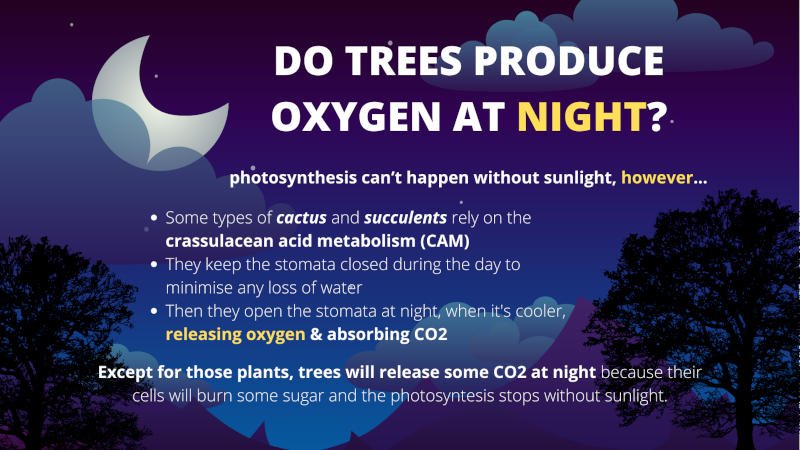
Given how oxygen is produced by trees, it is clear that photosynthesis can’t happen without sunlight, so, in general, trees will not produce oxygen at night.
However, there are some exceptions to this rule! Some plants, especially some types of cactus and succulents have a different way to perform photosynthesis that allows them to save water and emit some oxygen at night.
Those plants rely on the so-called crassulacean acid metabolism (CAM), which allows them to keep the stomata of their leaves closed during the day. They use this mechanism to minimise the loss of water during hot days because those plants grow in a hot and dry climate.
Then the leaf stomata will open at night when the temperatures are lower and the humidity is higher:
- Allow the release of some oxygen
- Absorb the necessary CO2
In truth, most of the trees are actually releasing CO2 at night. This is caused by the respiration of their cells, which need oxygen to burn the sugar they produced with photosynthesis. During this process, energy is released for the cell to function and CO2 is released. In any case, the CO2 produced by the trees at night is less than the oxygen they produce during daylight.
Do trees produce oxygen without leaves?
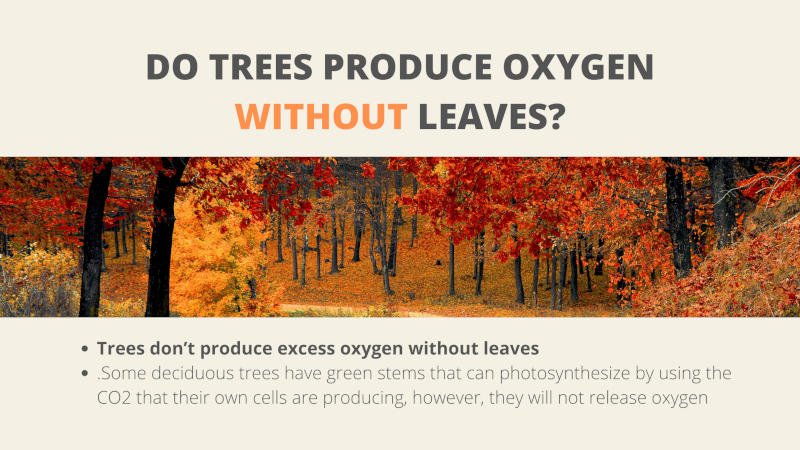
Trees don’t produce excess oxygen without leaves.
This means that deciduous trees like maple will stop releasing oxygen when they lose their leaves in autumn. Those trees will then compensate by producing a lot of oxygen in spring and summer when they will rapidly grow.
Some deciduous trees have green stems that can photosynthesize by using the CO2 that their own cells are producing, however, they will not release oxygen. The excess oxygen will instead be used by the cells of the tree to function.
Deciduous trees are essentially sleeping during winter, so they will not produce and release excess oxygen.
Do trees produce the most oxygen on earth?

It may come as a surprise to many, but most of the oxygen on our planet doesn’t come from trees!
Only about 28-30% of the oxygen in our atmosphere is produced by trees and grassland combined! So, who is producing the vast majority of the oxygen we breathe?
Most oxygen on earth doesn’t come from trees
Studies demonstrated that most of the oxygen is produced in the oceans by tiny micro-organisms called phytoplankton. The oxygen produced in the oceans accounts for a staggering 70% of the total!
Oceans absorb a staggering 10 billion tons of carbon dioxide every year and the phytoplankton is producing oxygen as a result of photosynthesis.
Phytoplankton is mostly found near the surface of the oceans, where the sunlight and nutrients are more abundant. Their population can be observed from satellites because it is changing the colour of the water.
When those microorganisms bloom, they provide food for a wide range of fish and other marine life.
Mature forests may not produce any excess oxygen
A recent study published on Nature shows that a mature forest may not be producing any excess oxygen. This may happen when the forest has already grown to its maximum density and the soil doesn’t contain enough nutrients to support further growth.
In this scenario, observed in an Australian mature forest, the trees will photosynthesize, produce sugar and release oxygen. However, without the necessary nutrients from the soil, the trees are then sending this sugar to the roots and feeding fungi and bacteria (that are releasing enough CO2 to offset the produced oxygen).
This may happen only when the forest is very mature and not when it is still growing. This scenario fits perfectly the mass conservation law I mentioned at the beginning of the article: if in some areas the forest can’t grow denser, then it will not store more carbon and release oxygen.
How Trees help the environment
We all know that planting trees is good for the environment and sustainability, but what makes them so beneficial for the planet?
Some of the main benefits of trees for the environment are:
- Trees provide part of the oxygen we breathe! Even if the vast majority of the oxygen comes from the oceans, trees are still providing a fair chunk of it.
- Trees clean the air from pollutants such as sulfur dioxide, nitrogen oxides and ammonia.
- Trees are storing carbon: it is estimated that a 40-year-old tree stores about 1 ton of carbon. Growing at an average of about 48 pounds of CO2 per year! This helps reduce the CO2 levels in the atmosphere.
- Trees prevent soil displacement and erosion: their roots keep the soil in place while their canopy lessens the impact of rainwater on the soil reducing erosion and reducing the risk of flooding.
- Trees help to mitigate the climate by providing shade and keeping the right levels of humidity.
- Trees provide food and shelter to wildlife, especially small mammals and birds.
The benefits of trees for society
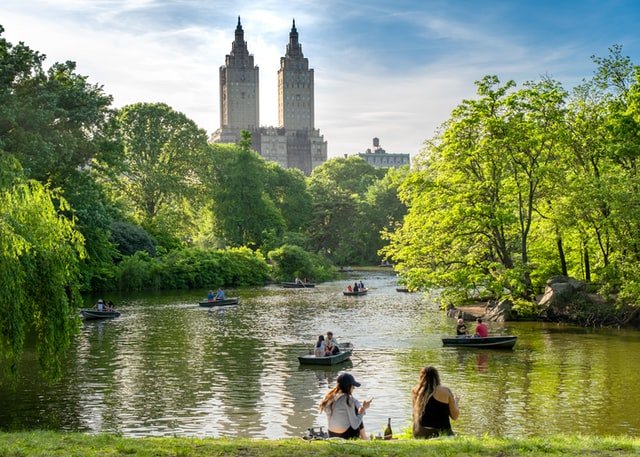
Trees are not only beneficial for the environment, but also for human society by improving social sustainability. Here are just some of the major benefits of trees for humankind:
- Trees provide wood: a renewable and eco-friendly resource with many different uses, from construction to furniture, cardboard for packaging, paper and art.
- Trees are used in sustainable urban design to improve the air quality, reduce the summer energy consumption of buildings by providing shade, promote community and social interactions, reduce noise, and much more. The use of trees in sustainable urban design represents one of the most interesting examples of sustainability.
- Trees can increase property values by up to 10%, An house with a beautiful garden with mature and elegant trees will be more appealing to potential buyers and attract a nice price premium. Depending on where your house is, consider planting a nice Red Maple, Spruce, Douglas-Fir, True-Fir or Beech tree in your yard, they will not only produce a lot of oxygen but also increase the value of your property more down the line. Planting an elegant oxygen producing tree is both a nice long term investment and a great thing for the environment and the quality of your home!
- Trees reduce stress: studies show that being around trees can help reduce the levels of stress hormones. Just think about the feeling you heave when hearing the gentle rustle of the leaves of a nearby tree while the wind gently blows through them… isn’t it relaxing? Of course, it is for most people.
- Trees can provide economic opportunities: with an increased focus on environmental responsibility, companies are increasingly looking at reducing their carbon footprints and shifting more and more toward renewable resources. Things like planting trees and preserving forests are becoming a growing business opportunity to serve the increasing demand coming from consumers and environmentally responsible businesses.
Conclusions
Knowing which trees produce the most oxygen, you should look at planting some of those trees in your yard if you can and have enough space.
This will improve the quality of the air around your house, improve the landscape and, potentially even substantially increase the value of your property in a few years!
Because the trees in my list are not only producing the most oxygen but are also extremely beautiful and pleasing to the eye. Let’s have a quick recap of those trees, and their characteristics:
| Most Oxygen Producing Trees | Maple Tree | Spruce Tree | Douglas-fir Tree | True-fir Tree | Beech Tree |
|---|---|---|---|---|---|
| Tree Type | Deciduous | Evergreen | Evergreen | Evergreen | Deciduous |
| Growth Rate (in/year) | About 36 in/year | About 30 in/year | About 24 in/year | About 20 in/year | About 20 in/year |
| Tree Lifespan | Up to 400 years | Up to 10000 years | Up to 1000 years | About 500 years | Up to 300 years |
If you are still unsure, just think about how gorgeous a nice Red Maple tree could look in your yard, or maybe an amazing True-Fir, that you could also decorate during the Christmas period!
Before planting one of those trees close to your house, it is best to consult with an expert to decide if you have enough space and how close you can put a specific tree to the house. The last thing you want is to have the roots of the tree damage your house.
However, if done properly, one of those most oxygen producing trees in your yard could be the perfect landscaping, relaxing and value choice with tons of benefits for you and your family in the coming years!
Learn more
- The oxygen cycle – Britannica
- How many trees does it take to produce oxygen for one person? (on average) – Science Focus
- How much oxygen comes from the ocean? – National Ocean Service
- Do Plants Emit Oxygen and Carbon Dioxide at Night? – Britannica

